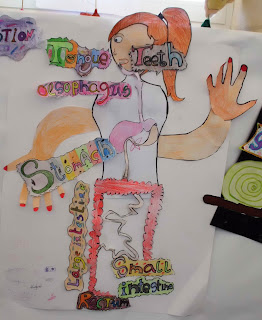19.12.12
REPORT: MAKING YOGHURT
Milk goes bad quicky, but we can preserve it by making yoghurt. We use a process called fermentation to make it. In this process bacteria change the carbohydrates in the milk into acid. The acid stops other micro-organisms growing in the food.
1. We needed a vacuum flask, some fresh milk, a pot of natural yoghurt, a gas hob, a pan, a wooden spoon and a bowl for the finished yoghurt.
2. We poured the milk into the pan and we let it heat to 30ºC. We stirred the milk and we didn't let it get too hot!
3. We let the milk cool a little. Then we added the natural yoghurt.
We stirred the mixture for about two minutes.
1. We needed a vacuum flask, some fresh milk, a pot of natural yoghurt, a gas hob, a pan, a wooden spoon and a bowl for the finished yoghurt.
2. We poured the milk into the pan and we let it heat to 30ºC. We stirred the milk and we didn't let it get too hot!
3. We let the milk cool a little. Then we added the natural yoghurt.
We stirred the mixture for about two minutes.
4. We put the mixture into a vacuum flask and we closed the lid.
5. We waited for twelve hours.
6. We opened the flask and we poured the yoghurt into a bowl.
7. We kept the yoghurt in the fridge.
9.12.12
ENDANGERED ANIMALS
Do you know what it means if an animal is "endangered"?
It means that there are
not many of that type of animal left in the world, and one day, they might all
be gone, which is called becoming "extinct".
How do animals become extinct?
- They lose their habitat, which means that there's nowhere for them to live. For example, many animals make their homes in the rain forests that are being cut down. Once all the trees are gone, there will be nowhere for these animals to live, so they will die.
- Some animals, like chimpanzees, are becoming extinct because people kill them to eat them.
- Animals are taken from the wild and sent to circuses and zoos, leaving fewer animals in nature to carry on the species.
- Some people shoot animals for fun. This is called "big game hunting", and if enough animals are killed this way, some animals could become extinct.
- Elephants are taken from the wild and forced to drag heavy machines to help people cut down forests. This is called "logging".
Some endangered especies:
Labels:
animals,
biodiversity,
community,
danger,
ecosystem,
endangered,
habitat,
project,
year 6
6.10.12
BE ACTIVE!
Here are some ways to keep your bones, muscles and nerves healthy:
- Always warm up before you exercise.
- Do some physical exercise every day.
- Wear a helmet and safety pads when you cycle, rollerblade or skateboard.
- Eat a healthy diet with lots of different food groups.
- Drink a lot of water when you are thirsty.
- Exercise your brain every day.
27.8.12
20.4.12
9.3.12
HOW TO SAVE ENERGY
Here we have an example of how we can save energy to protect our environment: light with less energy!!!
18.2.12
26.1.12
CLIMATE CHANGE
Year 5 students are learning the unit about Climate. You can watch a video below about how global warming dangers our planet producing climate change. Take a moment to think about it!
Subscribe to:
Posts (Atom)









































